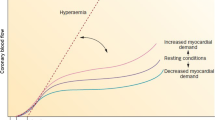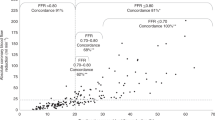Abstract
Coronary flow reserve (CFR) represents entire coronary compensatory capacity. While CFR assessment is recommended to identify patients at an increased risk of cardiovascular events and coronary microvascular dysfunction, invasive CFR measurement is often technically challenging. Although not well validated yet, pressure-bounded CFR (pbCFR) has been proposed as a simple surrogate to estimate impaired CFR. In this study, we evaluated coronary physiological characteristics of low pbCFR using detailed invasive assessment. Invasive physiological assessment including resting ratio of distal coronary pressure to aortic pressure (Pd/Pa), fractional flow reserve (FFR), resting and hyperemic mean transit time, index of microcirculatory resistance (IMR), CFR, resistive reserve ratio, and microvascular resistance reserve (MRR) was performed in 107 patients in the left anterior descending coronary artery. pbCFR was calculated only with resting Pd/Pa and FFR. Patients were divided into low pbCFR and non-low pbCFR groups. Of 107 patients, 50 (46.7%) had low pbCFR. FFR (0.90 ± 0.05 vs. 0.83 ± 0.05, p < 0.001), hyperemic mean transit time (0.27 ± 0.17 vs. 0.21 ± 0.12, p = 0.04), and IMR (20.4 ± 13.2 vs. 15.0 ± 9.1, p = 0.01) were significantly higher in the low pbCFR group than their counterpart. While directly measured CFR did not differ significantly (4.4 ± 2.3 vs. 5.1 ± 2.8, p = 0.18), MRR was lower in the low pbCFR group (5.4 ± 3.0 vs. 6.8 ± 3.8, p = 0.047). The rates of CFR < 2.0 and IMR ≥ 25 were not significantly different between the 2 groups. In conclusion, although CFR did not differ significantly, IMR and MRR were impaired in patients with low pbCFR, suggesting pbCFR as a potential surrogate of coronary microvascular function in clinical practice.



Similar content being viewed by others
References
Gould KL, Lipscomb K, Hamilton GW (1974) Physiologic basis for assessing critical coronary stenosis. Instantaneous flow response and regional distribution during coronary hyperemia as measures of coronary flow reserve. Am J Cardiol 33:87–94
Del Buono MG, Montone RA, Camilli M, Carbone S, Narula J, Lavie CJ, Niccoli G, Crea F (2021) Coronary microvascular dysfunction across the spectrum of cardiovascular diseases: JACC state-of-the-art review. J Am Coll Cardiol 78:1352–1371
Kelshiker MA, Seligman H, Howard JP, Rahman H, Foley M, Nowbar AN, Rajkumar CA, Shun-Shin MJ, Ahmad Y, Sen S, Al-Lamee R, Petraco R (2022) Coronary flow reserve and cardiovascular outcomes: a systematic review and meta-analysis. Eur Heart J 43:1582–1593
Kunadian V, Chieffo A, Camici PG, Berry C, Escaned J, Maas AHEM, Prescott E, Karam N, Appelman Y, Fraccaro C, Buchanan GL, Manzo-Silberman S, Al-Lamee R, Regar E, Lansky A, Abbott JD, Badimon L, Duncker DJ, Mehran R, Capodanno D, Baumbach A (2021) An EAPCI expert consensus document on ischaemia with non-obstructive coronary arteries in collaboration with European society of cardiology working group on coronary pathophysiology & microcirculation endorsed by coronary vasomotor disorders international study group. EuroIntervention 16:1049–1069
Knuuti J, Wijns W, Saraste A, Capodanno D, Barbato E, Funck-Brentano C, Prescott E, Storey RF, Deaton C, Cuisset T, Agewall S, Dickstein K, Edvardsen T, Escaned J, Gersh BJ, Svitil P, Gilard M, Hasdai D, Hatala R, Mahfoud F, Masip J, Muneretto C, Valgimigli M, Achenbach S, Bax JJ, ESC Scientific Document Group (2020) 2019 ESC Guidelines for the diagnosis and management of chronic coronary syndromes. Eur Heart J 41:407–477
Gulati M, Levy PD, Mukherjee D, Amsterdam E, Bhatt DL, Birtcher KK, Blankstein R, Boyd J, Bullock-Palmer RP, Conejo T, Diercks DB, Gentile F, Greenwood JP, Hess EP, Hollenberg SM, Jaber WA, Jneid H, Joglar JA, Morrow DA, O’Connor RE, Ross MA, Shaw LJ (2021) 2021 AHA/ACC/ASE/CHEST/SAEM/SCCT/SCMR guideline for the evaluation and diagnosis of chest pain: a report of the American college of cardiology/American heart association joint committee on clinical practice guidelines. Circulation 144:e368–e454
Barbato E, Aarnoudse W, Aengevaeren WR, Werner G, Klauss V, Bojara W, Herzfeld I, Oldroyd KG, Pijls NH, De Bruyne B, Week 25 study group (2004) Validation of coronary flow reserve measurements by thermodilution in clinical practice. Eur Heart J 25:219–223
Zimmermann FM, Pijls NHJ, De Bruyne B, Bech GJ, van Schaardenburgh P, Kirkeeide RL, Gould KL, Johnson NP (2017) What can intracoronary pressure measurements tell us about flow reserve? Pressure-Bounded coronary flow reserve and example application to the randomized DEFER trial. Catheter Cardiovasc Interv 90:917–925
Ahn JM, Zimmermann FM, Johnson NP, Shin ES, Koo BK, Lee PH, Park DW, Kang SJ, Lee SW, Kim YH, Lee CW, Park SW, Pijls NHJ, Park SJ (2017) Fractional flow reserve and pressure-bounded coronary flow reserve to predict outcomes in coronary artery disease. Eur Heart J 38:1980–1989
Sawano M, Yamaji K, Kohsaka S, Inohara T, Numasawa Y, Ando H, Iida O, Shinke T, Ishii H, Amano T (2020) Contemporary use and trends in percutaneous coronary intervention in Japan: an outline of the J-PCI registry. Cardiovasc Interv Ther 35:218–226
Kawase Y, Matsuo H, Kuramitsu S, Shiono Y, Akasaka T, Tanaka N, Amano T, Kozuma K, Nakamura M, Yokoi H, Kobayashi Y, Ikari Y (2022) Clinical use of physiological lesion assessment using pressure guidewires: an expert consensus document of the Japanese association of cardiovascular intervention and therapeutics-update 2022. Cardiovasc Interv Ther 37:425–439
Jang HJ, Koo BK, Lee HS, Park JB, Kim JH, Seo MK, Yang HM, Park KW, Nam CW, Doh JH, Kim HS (2013) Safety and efficacy of a novel hyperaemic agent, intracoronary nicorandil, for invasive physiological assessments in the cardiac catheterization laboratory. Eur Heart J 34:2055–2062
Lee SH, Lee JM, Park J, Choi KH, Hwang D, Doh JH, Nam CW, Shin ES, Hoshino M, Murai T, Yonetsu T, Mejía-Rentería H, Kakuta T, Escaned J, International Collaboration of Comprehensive Physiologic Assessment Investigators (2020) Prognostic implications of resistive reserve ratio in patients with coronary artery disease. J Am Heart Assoc 9:e015846
Toya T, Ahmad A, Corban MT, Ӧzcan I, Sara JD, Sebaali F, Escaned J, Lerman LO, Lerman A (2021) Risk stratification of patients with nonobstructive coronary artery disease using resistive reserve ratio. J Am Heart Assoc 10:e020464
Nishi T, Kitahara H, Saito Y, Nishi T, Nakayama T, Fujimoto Y, Matsumiya G, Kobayashi Y (2018) Invasive assessment of microvascular function in patients with valvular heart disease. Coron Artery Dis 29:223–229
Saito Y, Kitahara H, Nishi T, Fujimoto Y, Kobayashi Y (2019) Decreased resting coronary flow and impaired endothelial function in patients with vasospastic angina. Coron Artery Dis 30:291–296
van’t Veer M, Adjedj J, Wijnbergen I, Tóth GG, Rutten MC, Barbato E, van Nunen LX, Pijls NH, De Bruyne B (2016) Novel monorail infusion catheter for volumetric coronary blood flow measurement in humans: in vitro validation. EuroIntervention 12:701–707
De Bruyne B, Pijls NHJ, Gallinoro E, Candreva A, Fournier S, Keulards DCJ, Sonck J, Van’t Veer M, Barbato E, Bartunek J, Vanderheyden M, Wyffels E, De Vos A, El Farissi M, Tonino PAL, Muller O, Collet C, Fearon WF (2021) Microvascular resistance reserve for assessment of coronary microvascular function: JACC technology corner. J Am Coll Cardiol 78:1541–1549
Saito Y, Nishi T, Kato K, Kitahara H, Kobayashi Y (2022) Resistive reserve ratio and microvascular resistance reserve in patients with coronary vasospastic angina. Heart Vessels 37:1489–1495
Ong P, Camici PG, Beltrame JF, Crea F, Shimokawa H, Sechtem U, Kaski JC, Bairey Merz CN, Coronary Vasomotion Disorders International Study Group (COVADIS) (2018) International standardization of diagnostic criteria for microvascular angina. Int J Cardiol 250:16–20
Olsen RH, Pedersen LR, Snoer M, Christensen TE, Ghotbi AA, Hasbak P, Kjaer A, Haugaard SB, Prescott E (2016) Coronary flow velocity reserve by echocardiography: feasibility, reproducibility and agreement with PET in overweight and obese patients with stable and revascularized coronary artery disease. Cardiovasc Ultrasound 14:22
Perera D, Berry C, Hoole SP, Sinha A, Rahman H, Morris PD, Kharbanda RK, Petraco R, Channon K, UK Coronary Microvascular Dysfunction Working Group (2022) Invasive coronary physiology in patients with angina and non-obstructive coronary artery disease: a consensus document from the coronary microvascular dysfunction workstream of the British Heart Foundation/National Institute for Health Research Partnership. Heart. https://doi.org/10.1136/heartjnl-2021-320718
Wijntjens GWM, van Lavieren MA, van de Hoef TP, Echavarría-Pinto M, Meuwissen M, Stegehuis VE, Murai T, Escaned J, Piek JJ (2019) Pressure-derived estimations of coronary flow reserve are inferior to flow-derived coronary flow reserve as diagnostic and risk stratification tools. Int J Cardiol 279:6–11
Suda A, Takahashi J, Hao K, Kikuchi Y, Shindo T, Ikeda S, Sato K, Sugisawa J, Matsumoto Y, Miyata S, Sakata Y, Shimokawa H (2019) Coronary functional abnormalities in patients with angina and nonobstructive coronary artery disease. J Am Coll Cardiol 74:2350–2360
Layland J, Carrick D, McEntegart M, Ahmed N, Payne A, McClure J, Sood A, McGeoch R, MacIsaac A, Whitbourn R, Wilson A, Oldroyd K, Berry C (2013) Vasodilatory capacity of the coronary microcirculation is preserved in selected patients with non-ST-segment-elevation myocardial infarction. Circ Cardiovasc Interv 6:231–236
Fukuoka R, Kawasaki T, Umeji K, Okonogi T, Koga N (2022) The diagnostic performance of on-site workstation-based computed tomography-derived fractional flow reserve. Comparison with myocardium perfusion imaging. Heart Vessels 37:22–30
Takenaka H, Okamura T, Miyazaki Y, Fujimura T, Ono A, Nakamura T, Tateishi H, Mochizuki M, Akase H, Suetomi T, Uchinoumi H, Oda T, Yano M (2022) Serial changes in the quantitative flow ratio in patients with intermediate residual stenosis after percutaneous coronary intervention. Heart Vessels 37:363–373
Ando J, Otani K, Redel T, Minatsuki S, Kikuchi H, Kodera S, Komuro I (2022) Agreement between single plane and biplane derived angiographic fractional flow reserve in patients with intermediate coronary artery stenosis. Heart Vessels 37:549–554
Author information
Authors and Affiliations
Corresponding author
Ethics declarations
Conflict of interest
Yoshio Kobayashi reports research grants from Abbott Medical Japan. All other authors have reported that they have no relationships relevant to the contents of this paper to disclose.
Additional information
Publisher's Note
Springer Nature remains neutral with regard to jurisdictional claims in published maps and institutional affiliations.
Rights and permissions
Springer Nature or its licensor (e.g. a society or other partner) holds exclusive rights to this article under a publishing agreement with the author(s) or other rightsholder(s); author self-archiving of the accepted manuscript version of this article is solely governed by the terms of such publishing agreement and applicable law.
About this article
Cite this article
Yamazaki, T., Saito, Y., Yamashita, D. et al. Validation of pressure-bounded coronary flow reserve using invasive coronary physiologic assessment. Heart Vessels 38, 626–633 (2023). https://doi.org/10.1007/s00380-022-02215-8
Received:
Accepted:
Published:
Issue Date:
DOI: https://doi.org/10.1007/s00380-022-02215-8




